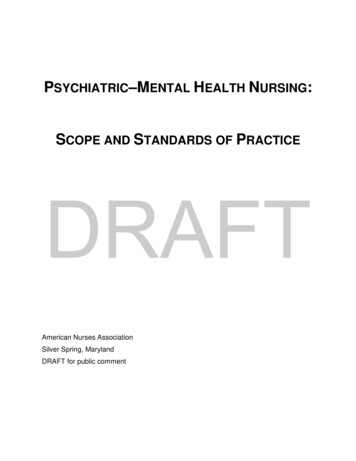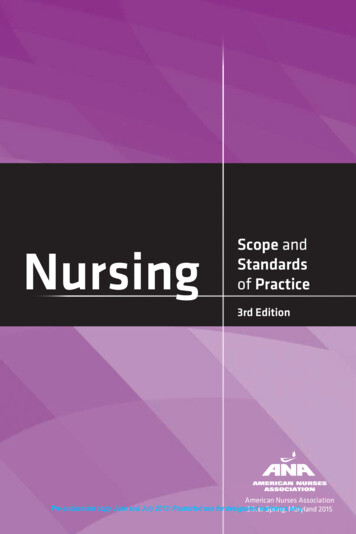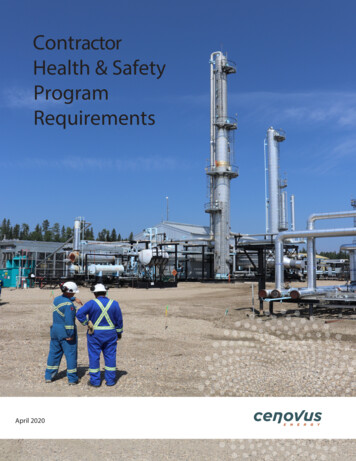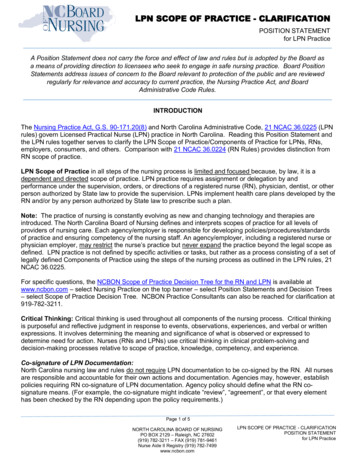
Transcription
PSYCHIATRIC–MENTAL HEALTH NURSING:SCOPE AND STANDARDS OF PRACTICEDRAFTAmerican Nurses AssociationSilver Spring, MarylandDRAFT for public comment
Psychiatric–Mental Health Nursing: Scope & Standards of Practice22012 workgroup SCOPE DRAFT for National Review ental Health Nursing: Scope of PracticeIntroductionHistory and Evolution of the SpecialtyOrigins of the Psychiatric–Mental Health Advanced Practice Nursing RoleCurrent Issues and TrendsPrevalence of Mental Disorders Across the Lifespan: Critical FactsSubstance abuse disorders: Prevalence and co-morbiditiesChildren and older adultsDRAFTDisparities in mental health treatmentOpportunities to Partner with Consumers for Recovery and WellnessStructure of a person-centered, recovery oriented public health care model: UnifyingeffortsPrevention: the promise of building resiliencyScreening and early interventionIntegrated careTechnology of a Public Health Model of Mental Health CareEmerging models of acute careWorkforce needed to construct a Public Health Model of Mental Health CareDefinition of Psychiatric–Mental Health NursingPhenomena of Concern for Psychiatric–Mental Health NursesLevels of Psychiatric–Mental Health Nursing PracticePsychiatric–Mental Health Registered Nurse (RN-PMH)Psychiatric–Mental Health Nursing Clinical Practice SettingsAcute Inpatient CareIntermediate and Long-Term CarePartial Hospitalization and Intensive Outpatient TreatmentResidential Services
Psychiatric–Mental Health Nursing: Scope & Standards of Practice32012 workgroup SCOPE DRAFT for National Review 11/20/12Community Based TreatmentAssertive Community Treatment (ACT)Definition of Psychiatric–Mental Health Advanced Practice Registered Nurse (PMHAPRN)Consensus Model- LACE [Licensure, Accreditation, Certification and Education]PsychotherapyPsychopharmacological InterventionsCase ManagementProgram Development and ManagementConsultation LiaisonClinical SupervisionDRAFTEthical Issues in Psychiatric–Mental Health NursingSpecialized Areas of PracticePrimary CareIntegrative ProgramsTelehealthSelf-EmploymentForensic Mental HealthDisaster Mental HealthStandards of PracticeStandard 1. AssessmentStandard 2. DiagnosisStandard 3. Outcomes IdentificationStandard 4. PlanningStandard 5. ImplementationStandard 5A. Coordination of CareStandard 5B. Health Teaching and Health PromotionStandard 5C. Milieu TherapyStandard 5D. Pharmacological, Biological, and Integrative Therapies
Psychiatric–Mental Health Nursing: Scope & Standards of Practice42012 workgroup SCOPE DRAFT for National Review 11/20/12Standard 5E. Prescriptive Authority and TreatmentStandard 5F. PsychotherapyStandard 5G. ConsultationStandard 6. EvaluationStandards of Professional PerformanceStandard 7. EthicsStandard 8. EducationStandard 9. Evidence Based Practice and ResearchStandard 10. Quality of PracticeStandard 11. CommunicationDRAFTStandard 12. LeadershipStandard 13. CollaborationStandard 14. Professional Practice EvaluationStandard 15. Resource UtilizationStandard 16. Environmental HealthStandard 17. LeadershipReferencesGlossary
Psychiatric–Mental Health Nursing: Scope & Standards of Practice52012 workgroup SCOPE DRAFT for National Review 11/20/12CONTRIBUTORSWork Group MembersKris A. McLoughlin, APNA Co-ChairCatherine F. Kane, ISPN Co-ChairKathleen DelaneyNikki DuWickKay FolandSara Horton-DeutschSue KrupnickSue OdegardenBethany PhoenixDRAFTPeggy PlunkettDiane SnowVictoria Soltis-JarrettChristine TebaldiEdilma YearwoodANA StaffCarol J. Bickford, PhD, RN-BC, CPHIMS – Content editorMaureen E. Cones, Esq. – Legal counselEric Wurzbacher, BA – Project editor
Psychiatric–Mental Health Nursing: Scope & Standards of Practice62012 workgroup SCOPE DRAFT for National Review 11/20/121Preface3Society of Psychiatric–Mental Health Nurses (ISPN) appointed a joint task force to5Nursing Practice published in 2007 by the American Nurses Association (ANA, 2007).7administrators, staff nurses, nursing faculty, and psychiatric advanced practice nurses92011, to conduct an analysis of the existing document and begin crafting sections2In 2011, the American Psychiatric Nurses Association (APNA) and the International4begin the review and revision of the Scope and Standards of Psychiatric–Mental Health6The taskforce members represented psychiatric–mental health nursing clinical8working in psychiatric facilities and the community. This taskforce convened in July,10incorporating the results of the analysis.12language of the most recent publication of ANA nursing standards, Nursing: Scope and14highlight the leadership role of psychiatric–mental health nurses in the transformation of16Freedom Commission Report on Mental Health (United States Department of Health18of Nursing (2010). The prevalence of mental health issues and psychiatric disorders20groups attest to the critical role that the specialty of psychiatric–mental health nursing22persons with psychiatric disorders and the nurses involved in assisting persons with24in an environment of fiscal constraints and disparities in reimbursement for mental26Development of Psychiatric–Mental Health Nursing: Scope and Standards of Practice28the American Psychiatric Nurses Association and the International Society of30http://www.ISPN-psych.org with links from the ANA website, http://nursingworld.org, andDRAFT11In accordance with ANA recommendations, this document reflects the template13Standards of Practice (ANA, 2010). In addition, the introduction has been revised to15the mental health system as outlined in Achieving the Promise, the President’s New17and Human Services, 2003) and the Institute of Medicine’s Report (IOM) on the Future19across the age span and the disparities in access to care and treatment among diverse21must continue to play in meeting the goals for a healthy society. Safety issues for23mental illness in their own recovery process are major priorities for this nursing specialty25health services.27includes a two-stage field review process: 1) review and feedback from the boards of29Psychiatric–Mental Health Nursing and 2) posting of the draft for public comment at
Psychiatric–Mental Health Nursing: Scope & Standards of Practice72012 workgroup SCOPE DRAFT for National Review 11/20/1231the APNA website, http://www.apna.org. Notice of the public comment period will be33nursing, faculty groups, and state nurses associations. All groups will be encouraged to35feedback will be carefully reviewed and integrated as appropriate.32distributed to nursing specialty organizations, state boards of nursing, schools of34disseminate notice of the postings to all of their members and other stakeholders. TheDRAFT
Psychiatric–Mental Health Nursing: Scope & Standards of Practice82012 workgroup SCOPE DRAFT for National Review 11/20/1236PSYCHIATRIC–MENTAL HEALTH NURSING:38Psychiatric–mental health nursing is a specialized area of nursing practice committed to40behavioral problems, psychiatric disorders and comorbid conditions. Psychiatric–mental42and a wide range of nursing, psychosocial, and neurobiological research evidence to44Introduction46professional nursing practice, defines its boundaries and informs society about the48state level nurse practice acts and the rules and regulations governing nursing practice.50designated limits, functions, and titles for nurses, particularly at the advanced practice52remains within the boundaries defined by their state practice acts. Individual nurses are54professional code of ethics, and professional practice standards.56preparation. The nurse’s role, position, job description, and work practice setting further58education, or research.60to the specialty practice of psychiatric–mental health nursing. The scope statement62specialty, its levels of practice based on educational preparation, current clinical37SCOPE OF PRACTICE39promoting mental health through the assessment, diagnosis, and treatment of41health nursing intervention is an art and a science, employing a purposeful use of self43produce effective outcomes.45The nursing profession, by developing and articulating the scope and standards of47parameters of nursing practice. The scope and standards also guide the development of49Because each state develops its own regulatory language about nursing, the51level, may differ significantly from state to state. Nurses must ensure that their practice53accountable for ensuring that they practice within the limits of their own competence,55Levels of nursing practice are differentiated according to the nurse’s educational57define practice. The nurse’s role may be focused on clinical practice, administration,59This document addresses the role, scope of practice, and standards of practice specific61defines psychiatric–mental health nursing and describes its evolution as a nursing63practice activities and sites, and current trends and issues relevant to the practice ofDRAFT
Psychiatric–Mental Health Nursing: Scope & Standards of Practice92012 workgroup SCOPE DRAFT for National Review 11/20/1264psychiatric–mental health nursing. The standards of psychiatric–mental health nursing66specialty describes the responsibilities for which its practitioners are accountable.68Psychiatric–mental health nursing began with late 19th century reform movements to70social treatment for the mentally ill. The “first formally organized training school within a72Asylum in Massachusetts in 1882 (Church, 1985). The use of trained nurses, rather74“insanity” as deviance or infirmity with a belief that mental illness could be ameliorated76US to allow men the opportunity to become trained nurses (Boyd, 1998). Eventually,78in general nursing skills could be provided to their students.80organized training course for psychiatric nursing within a general nursing education821998). This course served as a prototype for other nursing education programs.84Nursing Mental Disease, in 1920 (Boling, 2003). Under nursing leadership, psychiatric–86approaches to mental illness and began to identify the didactic and clinical components88in nervous and mental diseases” was added to curriculum guides developed by the90programs for registered nurses (Church, 1985).92during WWII. The public health significance of mental disorders became widely65practice are authoritative statements by which the psychiatric–mental health nursing67History and Evolution of the Specialty69change the focus of mental asylums from restrictive and custodial care to medical and71hospital for insane in the world” was established by Dr. Edward Cowles at McLean73than “keepers”, was central to Cowles’ effort to replace the public perception of75or cured with proper treatment. The McLean nurse training school was the first in the77asylum nursing programs established affiliations with general hospitals so that training79Early on, training for psychiatric nurses was provided by physicians. The first nurse-81program was established by Effie Jane Taylor at Johns Hopkins Hospital in 1913 (Boyd,83Taylor’s colleague, Harriet Bailey, published the first psychiatric nursing textbook,85mental health nursing developed a biopsychosocial approach with specific nursing87of training needed to care for persons with mental illness. In the post-WWI era, “nursing89National League for Nursing Education and was eventually required in all educational91The next wave of mental health reform and expansion in psychiatric nursing beganDRAFT
Psychiatric–Mental Health Nursing: Scope & Standards of Practice102012 workgroup SCOPE DRAFT for National Review 11/20/1293apparent as a significant proportion of potential military recruits were deemed unfit for95the large number of veterans with combat-related neuropsychiatric casualties led to97consultant to the American Psychiatric Association, Laura Fitzsimmons evaluated99These recommendations were supported by professional organizations and followed by94service as a result of psychiatric disability. In addition, public attention and sympathy for96increased support for improving mental health services. As a psychiatric nurse98educational programs for psychiatric nurses and recommended standards of training.100federal funding to strengthen educational preparation and standards of care for102The national focus on mental health, combined with admiration for the heroism shown104mental health disciplines named in the National Mental Health Act (NMHA) of 1946.106(Silverstein, 2008) and led to a growth in university-level nursing education. In 1954,108University.110health nursing (PMH). Funding provided by the NMHA led to a rapid expansion in112the first journals focused on psychiatric-mental health nursing were published. In 1973,114began certifying generalists in psychiatric-mental health nursing (Boling, 2003).116therapeutic relationship in helping individuals to make positive behavior changes,118The process of deinstitutionalization, when the majority of care for persons with120began in the late 1950s. Contributing factors included the establishment of Medicare122legislation supporting construction of community mental health centers (Boling, 2003).101psychiatric nursing (Silverstein, 2008).103by nurses during the war, led to the inclusion of psychiatric nursing as one of the core105This act greatly increased funding for psychiatric nursing education and training107Hildegard Peplau established the first graduate psychiatric nursing program at Rutgers109The post-war era was marked by growing professionalization in psychiatric-mental111graduate programs, psychiatric-mental health nursing research was begun, and in 1963113the ANA first published the Standards of Psychiatric-Mental Health Nursing Practice and115Peplau’s Interpersonal Relations in Nursing, which emphasized the importance of the117articulated the predominant psychiatric-mental health nursing approach of the period.119psychiatric illness began to shift away from hospitals and toward community settings,121and Medicaid, changing rules governing involuntary confinement and the passage ofDRAFT
Psychiatric–Mental Health Nursing: Scope & Standards of Practice112012 workgroup SCOPE DRAFT for National Review 11/20/12123Although psychiatric-mental health nurses prepared at the undergraduate level125also began to practice in community-based programs such as day treatment and127Mental health care in the US began another transformation in the 1990s, the “Decade of129market, combined with economic pressures to reduce hospital stays forced by managed131to stabilize acute symptoms. Shorter hospital stays and higher acuity began to shift133advocated by Peplau, moving toward interventions focused on stabilization and135content on psychopharmacology and the pathophysiology of psychiatric disorders.137integrated care and treatment of those persons with co-occurring psychiatric and139occurring medical and psychiatric disorders. Integrated care emphasizes that both types141Also, since the Substance Abuse and Mental Health Services Administration (SAMHSA)143mental health care in America (SAMHSA, 2006), psychiatric-mental health nursing is145care. This continuum includes settings where psychiatric-mental health nurses have147and homeless outreach services. Psychiatric-mental health nursing is also called on to149personnel, veterans and their families experiencing war-related mental health124continued to work primarily in hospital-based and psychiatric acute care settings, many126assertive community treatment teams.128the Brain.” The dramatic increase in the number of psychiatric medications on the130care, resulted in briefer psychiatric hospitalizations characterized by use of medication132psychiatric nursing practice away from the emphasis on relationship-based care134immediate safety. Psychiatric-mental health nursing education began to include more136More recent trends in psychiatric-mental health nursing include an emphasis on138substance use disorders as well as integrated care and treatment of those with co-140of disorder are primary and must be treated as such.142has declared that recovery is the single most important goal in the transformation of144moving to integrate person-centered recovery-oriented practice across the continuum of146historically worked, such as hospitals, as well as emergency rooms, jails and prisons,148develop and apply innovative approaches in carefor the large population of military150conditions as a result of recent conflicts in Iraq and Afghanistan.DRAFT
Psychiatric–Mental Health Nursing: Scope & Standards of Practice122012 workgroup SCOPE DRAFT for National Review 11/20/12151Major developments in the nursing profession have corresponding effect within153of Nursing: Leading Change to Advance Health, has strengthened the role of155leaders, in both national and international arenas. Nursing's emphasis on use of157improvements in psychiatric-mental health nursing practice.159Specialty nursing at the graduate level began to evolve in the late 1950s in response to161Institute of Mental Health in 1949. The National Mental Health Act of 1946 identified163and treatment, along with psychiatry, psychology, and social work. Nurses played an165increasing awareness of post-war mental health issues (Bigbee & Amidi-Nouri, 2000).167health professionals.169conferred at Rutgers University in 1954 under the leadership of Hildegard Peplau. In171and consultants, graduate education in psychiatric–mental health nursing was designed173psychiatric disorders, and provide individual, group, and family therapy. Psychiatric175establishing national specialty certification through the American Nurses Association.177psychiatric-mental health clinical nurse specialist (PMHCNS) practice into community179crucial role in helping deinstitutionalized mentally ill persons adapt to community life.152psychiatric-mental health nursing. The Institute of Medicine's (2010) report, The Future154psychiatric-mental health nurses as mental health policy and program development156research findings to develop and implement evidence-based practice is driving158Origins of the Psychiatric–Mental Advanced Practice Health Nursing Role160the passage of the National Mental Health Act of 1946 and the creation of the National162psychiatric nursing as one of four core disciplines for the provision of psychiatric care164active role in meeting the growing demand for psychiatric services that resulted from166The incidence of “battle fatigue” led to the recognition of the need for more mental168The first specialty degree in psychiatric–mental health nursing, a master’s degree, was170contrast to existing graduate nursing programs that focused on developing educators172to prepare nurse therapists to assess and diagnose mental health problems and174nurses pioneered the development of the advanced practice nursing role and led in176The Community Mental Health Centers Act of 1963 facilitated the expansion of178and ambulatory care sites. These master’s and doctorally prepared PMHCNSs fulfilled aDRAFT
Psychiatric–Mental Health Nursing: Scope & Standards of Practice132012 workgroup SCOPE DRAFT for National Review 11/20/12180Traineeships to fund graduate education provided through the National Institute of182late 1960s PMHCNSs were providing individual, group, and family psychotherapy in a184also functioning as educators, researchers, and managers, and were working in186Another significant shift occurred as research renewed the emphasis on the188medications with fewer side effects were developed, psychopharmacology assumed a190encompass the expanding biopsychosocial perspective and the competencies required192graduate nursing programs added neurobiology, advanced health assessment,194psychiatric illness to their curricula. Similarly, preparation for prescriptive privileges196programs (Kaas & Markley, 1998).198changes in advanced practice psychiatric nursing. These trends included:181Mental Health played a significant role in expanding the PMHCNS workforce. By the183broad range of settings and were obtaining third-party reimbursement. PMHCNSs were185consultation-liaison positions or in the area of addictions. These roles continue today.187neurobiologic basis of mental illness and addiction. As more efficacious psychotropic189more central role in psychiatric treatment. The role of the PMHCNS evolved to191for practice were kept congruent with emerging science. Many psychiatric-mental health193pharmacology, pathophysiology, and the diagnosis and medical management of195became embedded in advanced practice psychiatric–mental health nursing graduate197Other trends in mental health and the larger healthcare system sparked other significant199DRAFT 200201research, leading to a dramatic decline in enrollment in psychiatric nursinggraduate programs (Taylor, 1999);202 204 206 203205207A shift in National Institute of Mental Health (NIMH) funds from education toAn increased awareness of physical health problems in mentally ill persons livingin community settings (Chafetz et al., 2005);The shift to primary care as a primary point of entry for comprehensive healthcare, including psychiatric specialty care;The growth and public recognition of the nurse practitioner role in primary caresettings.
Psychiatric–Mental Health Nursing: Scope & Standards of Practice142012 workgroup SCOPE DRAFT for National Review 11/20/12208In response to these challenges, psychiatric nursing graduate programs modified their210and management of common physical health problems, and a continued focus on212prescriptive authority. The tremendous expansion in the use of nurse practitioners in214registered nurse in some state nurse practice acts and for many in the general public. In216regulations, psychiatric-mental health nursing began utilizing the title Nurse218requirements for NP credentialing (Wheeler & Haber, 2004; Delaney et al., 1999). The220publication of the Psychiatric–Mental Health Nurse Practitioner Competencies (National222organizations sponsored by the National Organization of Nurse Practitioner Faculty.224title of CNS or NP, share the same core competencies of clinical and professional226certification for new graduates of advanced practice programs, titled Psychiatric-Mental228Clinical Nurse Specialists will continue to practice under this title.230Since the arrival of the landmark report Achieving the Promise: Transforming Mental232sensitized to the need for a recovery-oriented mental health system. Further, in 2010,234awards to five national behavioral healthcare provider associations, including the236adoption of recovery-based practices in the delivery of mental health services. This209curricula to include greater emphasis on comprehensive health assessment and referral211educational preparation to meet the state criteria and professional competencies for213primary care settings had made nurse practitioner synonymous with advanced practice215response to conditions including public recognition of the role, market forces and state217Practitioner and modifying graduate psychiatric nursing programs to conform with219Psychiatric–Mental Health Nurse Practitioner role was clearly delineated by the221Panel, 2003), the product of a panel with representation from a broad base of nursing223Psychiatric–Mental Health Advanced Practice Nurses, whether they practice under the225practice. Although psychiatric-mental health nursing is moving toward a single national227Health Nurse Practitioner, persons already credentialed as Psychiatric-Mental Health229Current Issues and Trends231Health Care in America (DHHS, 2003) mental health professionals have been233The Substance Abuse and Mental Health Services Administration (SAMHSA) approved235American Psychiatric Nurses Association, to promote awareness, acceptance, andDRAFT
Psychiatric–Mental Health Nursing: Scope & Standards of Practice152012 workgroup SCOPE DRAFT for National Review 11/20/12237theme of integrating recovery in practice has been echoed in Leading Change239recovery is endorsed as the essential platform for treatment along with seven other foci:241outcomes, trauma and justice, military families, and public awareness and support.243and Prevention (CDC) and the Institute of Medicine, and have been endorsed by245The current mental health treatment landscape has also been shaped by247Care Act (PPACA) brought, among other transformational changes, the promise of249capacity to address anticipated demand. In the midst of launching this landmark policy,251immediate impacts on mental health services and became a harbinger of a decade of253focusing event was the publication of data on the medical co-morbidities and decreased255data hastened the movement towards integrated behavioral/primary care with the257innovations in integrated care delivery.259aim of the broader federal policy agenda: improving the experience of care, improving261& Whittington, 2008). This shift is accompanied by significant payment reform (most263with healthcare consumers (Onie, Farmer, & Behforouz, 2012). This federal focus is265Medicaid into a capitated system (Manderscheid, 2012). This shifting re-imbursement238SAMHSA’s (2011) most recent statement on federal priorities in mental health. Here240prevention, health reform, health information technology (IT), data/quality and242These themes are echoed in important reports from the Centers for Disease Control244consumer groups.246multiple legislative and economic developments. The Patient Protection and Affordable248expanded health care coverage, and with it an assessment of the current system's250the economic downtown reverberated through federal and state budgets creating252fiscally conservative policies (National Alliance on Mental Illness, 2011). Another major254life expectancy of individuals with serious mental illness (McGuire et al., 2002) These256Center for Medicaid and Medicare Services (CMS) monies rapidly shifting to fund258The mental health initiatives of the PPACA and SAMHSA are also affected by the triple260the health of populations, and reducing per capita costs of health care (Berwick, Nolan,262prominently the return of case based and capitation models) and a call for partnership264finding its way into mental health care, particularly via initiatives to move Medicare and266structure reflects the realization that engineering a significant impact on the mentalDRAFT
Psychiatric–Mental Health Nursing: Scope & Standards of Practice162012 workgroup SCOPE DRAFT for National Review 11/20/12267health of individuals demands building healthy communities that increase support,269health care system must be equally focused on prevention, quality, an integrated271the consumer.273Despite the promise of recovery, the prevalence of mental illness continues to impose a275preceding year an estimated 9.8 million adults aged 18 and older in the United States277episode. More recent incidence data (CDC, 2011) indicates that that 6.8% of U.S.2792 weeks before the survey was administered. In a multi-state survey spanning two year281and 2008 (16.1%) and the prevalence of lifetime diagnosis of anxiety disorders was283Survey data on lifetime diagnosis of bipolar disorder and schizophrenia2850.6% had received a diagnosis of schizophrenia (CDC, 2011).287distressingly low. In 2010, fewer than 40% of the 45.9 million adults with mental illness289individuals with Serious Mental Illness (SMI)-approximately 60 percent of the 11.4291In 2006, health professionals were shaken by data demonstrating the increased293health issues (Parks, Svendsen, Singer, & Forti, 2006). The shocking statistic that, on268reduce disparities, and promote the resiliency of its members. This 21st Century mental270approach to health, and a paradigm shift that puts mental health care into the hands of272Prevalence of Mental Disorders across the Lifespan: Critical facts274significant burden on individuals. According to 2008 SAMSHA data, during the276had a serious mental illness and 2 million youth aged 12 to 17 had a major depressive278adults had a diagnosable episode of depression as measured by the PHQ-9 during the280collection points, the reported rates of lifetime depression were similar in 2006 (15.7%)28211.3% in 2006 and 12.3% in 2008. Finally in 2007, the National Health Interview284indicated that 1.7% of participants had received a diagnosis of bipolar disorder, and286Although the prevalence of mental illness remains high, treatment rates are288had received any mental health services. The figure only improved slightly for those290million adults with SMI in the past year received treatment (SAMHSA, 2012).292mortality and high prevalence of chronic medical conditions in individuals with mentalDRAFT
Psychiatric–Mental Health Nursing: Scope & Standards of Practice172012 workgroup SCOPE DRAFT for National Review 11/20/12294average, people with serious mental illness (SMI) die 25 years earlier than those296effects of the severe mental illness (Prince et al., 2007), has lent increased urgency to2982010). In addition to premature mortality, co-morbidity of chronic physical and mental300conditions are more likely to be have scores that place them in the top 10% of persons302healthcare costs (Melek & Norris, 2008) with only a small fraction of those costs (16%)304Substance abuse disorders: prevalence and co-morbidities306to substance use. This figure is expected to double in 2020, particularly with adults over308Penne, 2009).310illness are also of great concern. The National Drug Use and Health312abuse of either illicit drugs or alcohol (SAMSHA, 2009). This figure puts co-occurring314higher than SUD in the general population (SAMSHA, 2012). These individuals,316traumatic stress disorder (PTSD), demonstrate poorer outcomes (Najt, Fusar-Poli, &318Children and older adults320adult population. It is estimated that approximately 13 percent of children ages 8 to 15295without these illnesses, and little of that increased mortality is accounted for by direct297the call for integration of
DRAFT Psychiatric–Mental Health Nursing: Scope & Standards of Practice 6 2012 workgroup SCOPE DRAFT for National Review 11/20/12 Preface1 2 In 2011, the American Psychiatric Nurses Association (APNA) and the International 3 Society of Psychiatric–Mental Health Nurses (ISPN) appointed a joint task force to 4 begin th










